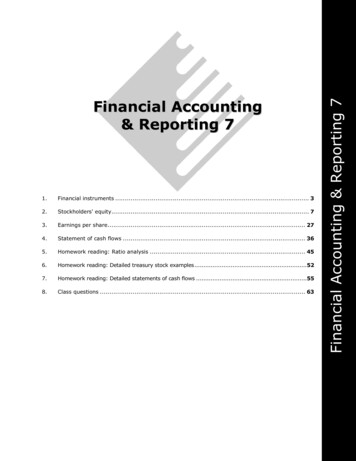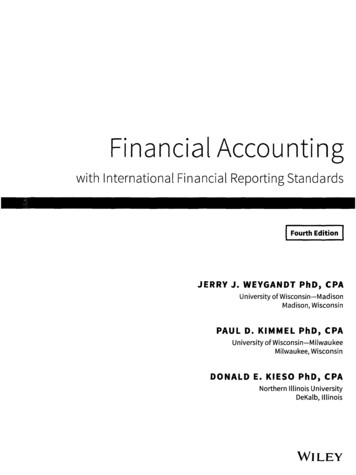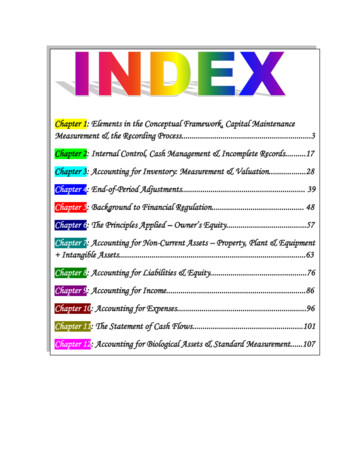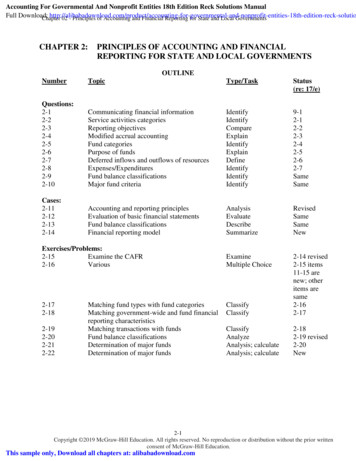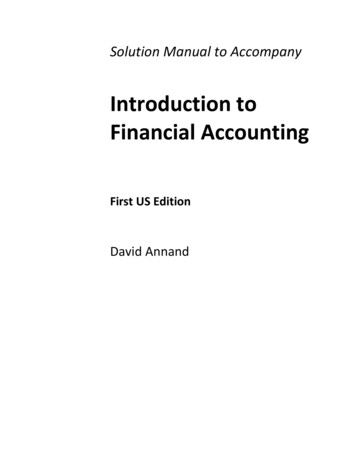
Transcription
Solution Manual to AccompanyIntroduction toFinancial AccountingFirst US EditionDavid Annand
Copyright 2018 David AnnandPublished by David AnnandBox 308, Rochester AB T0G 1Z0ISBN 978‐1‐989263‐05‐1Library and Archives Canada Cataloguing in PublicationAnnand, David, 1954–This solutions manual is licensed under a Creative Commons License,Attribution–Non‐commercial–Share Alike 4.0 USA: seewww.creativecommons.org. This material may be reproduced for non‐commercial purposes and changes may be used by others provided thatcredit is given to the author.To obtain permission for uses beyond those outlined in the CreativeCommons license, please contact David Annand atdavida@athabascau.ca.Latest version available at nd‐edd/Please forward suggested changes to davida@athabascau.ca.First US EditionJuly 31, 2018
TABLE OF CONTENTSCHAPTER ONEIntroduction to Financial Accounting . 1CHAPTER TWOThe Accounting Process . 21CHAPTER THREEFinancial Accounting and the Use of Adjusting Entries . 63CHAPTER FOURThe Classified Balance Sheet and Related Disclosures . 103CHAPTER FIVEAccounting for the Sale of Goods . 117CHAPTER SIXAssigning Costs to Merchandise . 157CHAPTER SEVENCash and Receivables . 191CHAPTER EIGHTLong‐lived Assets. 209CHAPTER NINEDebt Financing: Current and Non‐current Liabilities . 235CHAPTER TENDebt Financing: Bonds . 253CHAPTER ELEVENEquity Financing . 275CHAPTER TWELVEProprietorships and Partnerships . 301CHAPTER THIRTEEN Financial Statements Analysis . 317CHAPTER FOURTEEN The Statement of Cash Flows . 341
CHAPTER ONEIntroduction to FinancialAccountingConcept Self‐check1.Managerial accounting serves the decision‐making needs of internal users. Financialaccounting focuses on external reporting and meeting the needs of users like creditorsand stockholders.2.Business organizations sell products and services for profit. A non‐business organizationexists to meet various societal needs and does not have profit as a goal. Examples ofnon‐business organizations are churches, mosques, and hospitals.3.There are three common forms of business organizations—a proprietorship, apartnership, and a corporation. A proprietorship is a business owned by one person. Apartnership is a business owned by two or more individuals. A corporation is a businessowned by one or more stockholders.4.Limited liability means that the stockholders of a corporation are not responsible for thecorporation’s debts. The most that stockholders can lose is what they invested in thecorporation.5.Generally accepted accounting principles (GAAP) refer to the guidelines for financialaccounting used in any given jurisdiction. They include the standards and common,agreed practices that accountants follow in recording and summarizing financialinformation, and in the preparation of financial statements.CHAPTER ONE / Introduction to Financial Accounting First US Edition1
Concept Self‐check continued6.The six qualitative characteristics of GAAP are relevance, faithful representation,comparability, verifiability, timeliness, and understandability. relevant information has the ability to make a difference in the decision‐makingprocess; faithful representation means that information is complete, neutral, and free fromerror; comparability tells users of the information that businesses utilize similar accountingpractices; verifiability means that others are able to confirm that the information accuratelyrepresents the economic activities of the business; timely information is available to decision makers while it is still useful; and understandable information is clear and concise.7.Financial statements evaluate the performance of an entity and measure its progress.Financial information is collected, then summarised and reported in the financialstatements (balance sheet, income statement, statement of cash flows, and statementof changes in equity).8.The purpose of the income statement is to communicate the inflow of assets, in theform of revenues, and the outflow or consumption of assets, in the form of expenses,over a period of time. Total inflows greater than total outflows creates net income orprofit, which is reported on the income statement and in retained earnings in thestockholders’ equity section of the balance sheet. The purpose of the balance sheet is tocommunicate what the entity owns (its assets), what the entity owes (its liabilities), andthe difference between assets and liabilities (its equity) at a point in time.9.Revenue is an increase in an entity’s assets or a decrease in liabilities in return forservices performed or goods sold, expressed in monetary units like dollars. An expenseis an asset that is used up or obligations incurred in selling goods or performing services.10. Net income is the difference between revenues and expenses. It is one measure of thesuccess of the entity.11. The statement of changes in equity shows why common stock and retained earningshave changed over a specified period of time – for instance, when shares are issued ornet income is earned.12. Stockholders’ equity consists of common stock and retained earnings. Common stockrepresents how much stockholders have invested. Retained earnings is the sum of allnet incomes earned (net of losses incurred) by a corporation over its life, less anydistributions of these net incomes to stockholders.13. Dividends are distributions of retained earnings to stockholders.2CHAPTER ONE / Introduction to Financial Accounting First US Edition
Concept Self‐check continued14. The balance sheet consists of assets, liabilities, and stockholders’ equity. Liabilities plusstockholders’ equity always equal assets.15. An asset is anything of value that is owned by the entity. Assets are economic resourcescontrolled by an entity. They have some future value to the entity, usually for usedgenerating revenue.16. A liability is an obligation to pay an asset or to provide services or goods in the future.Until the obligations are paid, creditors have claims against the assets of the entity.Stockholders’ equity represents the amount of assets owing to the owners of the entity.The total assets of an entity belong either to the stockholders or to the creditors.17. The statement of cash flows (SCF) explains how the cash reported on the balance sheetchanged over a period of time by detailing its sources and uses of cash. The incomestatement does not disclose all important activities of the entity involving cash that isshown on the SCF, like investment in long‐lived assets or repayment of debt.18. Notes to the financial statements provide greater detail about various amounts shownin the financial statements, or provide non‐quantitative information that is useful tousers, like loan repayment terms.19. The double entry accounting system is used to record financial transactions. Eachtransaction affects at least two items in the accounting equation, in order to maintain itsequality. For example,a. Revenue is earned in cash: The asset Cash increases and Stockholders’ Equityincreases by the same amount. (Net income increases. This increases RetainedEarnings, which is part of Stockholders’ Equity.)b. An obligation is paid: The liability Accounts Payable decreases and the asset Cashdecreases by the same amount.c. An amount owing from a customer is collected: The asset Cash increases and theasset Accounts Receivable decreases equally.In this way, the accounting equation always remains in balance after each transaction isrecorded.20. Financial statements are prepared at regular intervals to keep a number of interestedgroups informed about the financial performance of a corporation. The timing isdetermined in response to the needs of management in running the entity or of outsideparties, such as bankers and stockholders. These external users make lending orinvesting decision in part based on the financial statements.CHAPTER ONE / Introduction to Financial Accounting First US Edition3
Concept Self‐check continued21. The accounting equation takes the following form:ASSETS LIABILITIES STOCKHOLDERS’ EQUITY(Economic resources(Creditors’ claims to assets)(Owners’ claims to assets,owned by an entity)or residual claims)The entity has assets, which are the resources it owns. The total assets owned by anentity must always equal the total claims of creditors and owners, who have the residualclaims.22. The exchange of assets or obligations by a business entity, expressed in monetary termslike dollars, is called a financial transaction. The exchange of cash for land or a building isan example of such a transaction.CP 1–1A( )( )(‐)( )( )(‐)( )(‐) L E( )( )(‐)(‐)No EffectNo Effect(‐)( )(‐)( )(‐)(‐)( )(‐)( )(‐)(‐)( )(‐)(‐)(‐)4(‐)(‐)( )(‐)Issued common stock for cashPurchased a truck for cashReceived a bank loan to pay for equipmentPurchased the equipment for cashMade a deposit for electricity service to be provided inthe futurePaid rent for the month just endedSigned a new union contract that provides forincreased wages in the futureHired a messenger service to deliver letters during a mailstrikeReceived a parcel; paid the delivery serviceBilled customers for services performedMade a cash payment to satisfy an outstanding obligationReceived a payment of cash in satisfaction of an amountowed by a customerCollected cash from a customer for services rendered thesame dayPaid cash for truck expenses (gas, oil, etc.)Made a monthly payment on the bank loan; this paymentincluded a payment on part of the loan and also anamount of interest expense. Stockholders’ equity isaffected because interest expense is incurredIssued shares in the company to pay off a loanPaid a dividend with cash.CHAPTER ONE / Introduction to Financial Accounting First US Edition
CP 1–21Issued common stock for cash ( ) Cash ( ) Common Stock5Paid an account payable (‐) Cash (‐) Accounts Payable2Borrowed money from a bank ( ) Cash ( ) Bank Loan3Collected an account receivable ( ) Cash (‐) Accounts Receivable1Collected a commission on a sale made today ( ) Cash ( ) Revenue [or ( ) AccountsReceivable ( ) Revenue, then ( ) Cash (‐) Accounts Receivable if the sale is firstrecorded as an account receivable]4Paid for this month’s advertizing in a newspaper (‐) Cash (‐) Expense [or ( ) AccountsPayable (‐) Expense, then (‐) Cash (‐) Accounts Payable if the bill is first set up as anAccounts Payable]2Repaid money borrowed from a bank (‐) Cash (‐) Bank LoanXSigned a contract to purchase a computer NO EFFECT6Received a bill for supplies used during the month ( ) Accounts Payable (‐) Expense3Received a cash payment in satisfaction of an amount owed by a customer ( ) Cash (‐)Accounts Receivable1Sent a bill to a customer for repairs made today ( ) Accounts Receivable ( ) Revenue3Sold equipment for cash ( ) Cash (‐) Equipment2Purchased a truck on credit, to be paid in six months ( ) Truck ( ) Accounts Payable (orLoan)XRequested payment from a customer of an account receivable that is overdue NOEFFECTXIncreased vacations for employees from four weeks to six weeks NO EFFECT6Recorded the amount due to the landlord as rent ( ) Accounts Payable (‐) Expense6Received the monthly telephone answering service bill ( ) Accounts Payable (‐)ExpenseCHAPTER ONE / Introduction to Financial Accounting First US Edition5
CP 1–3ASSETSCash LIABILITIES Equipment A. Retained earningsB. Accounts payableC. CashD. Retained earningsE. Equipment STOCKHOLDERS’ EQUITYAccounts Payable Common Stock Retained Earnings 5,000 (3,000 8,000 ‐ 4,000 ‐ 2,000) 3,000 (1,000 6,000 ‐ 3,000 ‐ 1,000) 1,000 (4,000 ‐ 1,500 ‐ 3,000 ‐ 500) 6,000 (6,000 7,000 ‐ 3,000 ‐ 4,000) 3,500 (2,500‐4,500‐500‐1,000)CP 1–4ASSETS LIABILITIES STOCKHOLDERS’ EQUITYStockholders’ equity at Jan. 1 10,000 ( 50,000 – 40,000)Stockholders’ equity at Dec. 31 15,000 ( 35,000 – 20,000)The increase in stockholders’ equity during the year was 5,000 ( 15,000‐10,000). This mustbe the net income amount.CP EAECHAPTER ONE / Introduction to Financial Accounting First US Edition
CP 1–61.ASSETS Cash Accounts receivable Unused supplies Land Building Equipment 33,000 82,000 2,000 25,000 70,000 30,000 242,0002.LIABILITIES Bank loan Accounts payable 15,000 27,000 42,0003.ASSETSS/H EQUITY LIABILITIES STOCKHOLDERS’ EQUITY 242,000 ‐ 42,000 200,000RET. EARN. 40,000 – 1,000 39,000Since stockholders’ equity is 200,000 and retained earnings is 39,000, common stock mustbe 161,000.CHAPTER ONE / Introduction to Financial Accounting First US Edition7
CP 1–7Income StatementFor the Month Ended January 31, 2019RevenueService feesExpensesInsuranceMiscellaneousOffice SuppliesWagesTotal expensesNet income 20,000 1,5002,5001,0009,00014,000 6,000Statement of Changes in EquityFor the Month Ended January 31, 2019Opening balanceStock issuedNet incomeDividendsEnding balanceCommonstock ‐0‐4,000‐ 4,000Retainedearnings ‐0‐6,000(2,000) 4,000Totalequity ‐0‐4,0006,000(2,000) 8,000Balance SheetAt January 31, 2019AssetsCashAccounts receivableMerchandise inventoryTotal assets 1,0004,0008,000 13,0
Introduction to Financial Accounting Concept Self‐check 1. Managerial accounting serves the decision‐making needs of internal users. Financial accounting focuses on external reporting and meeting the needs of users like creditors and stockholders. 2. Business organizations sell products and services for profit. A non‐business organization




